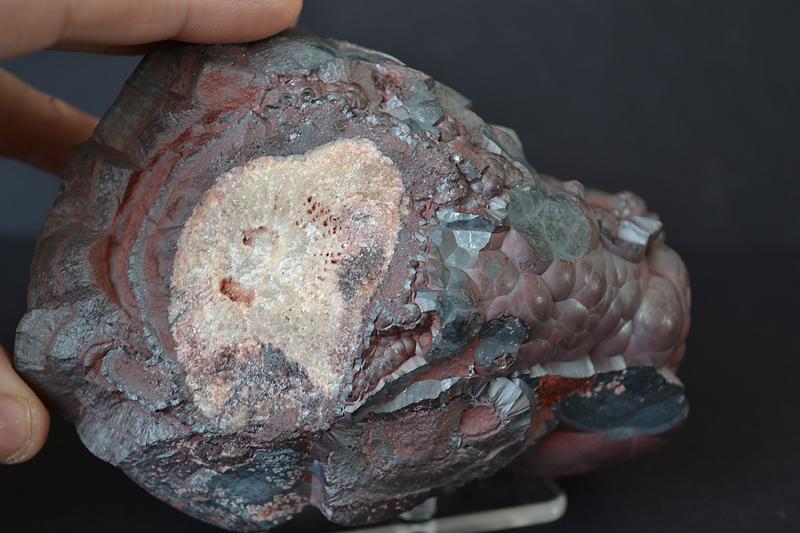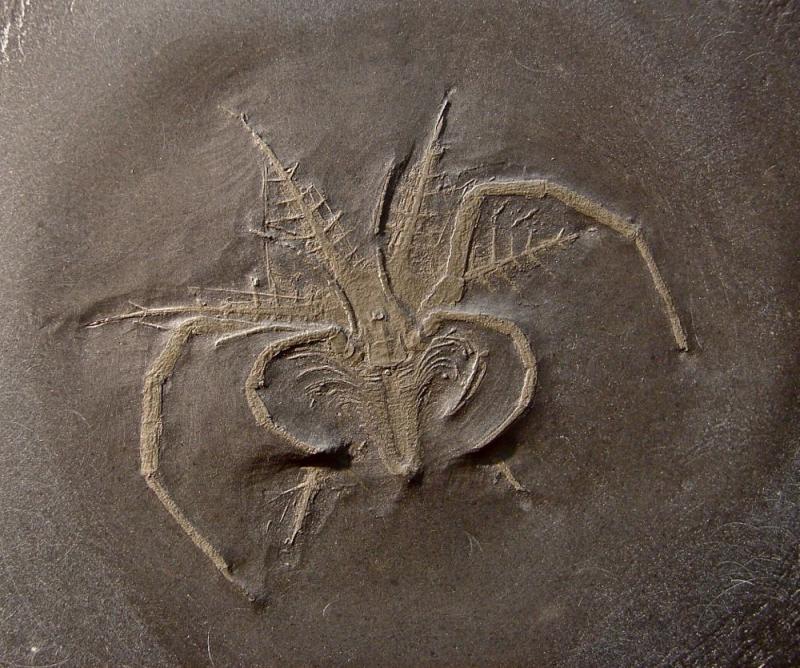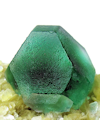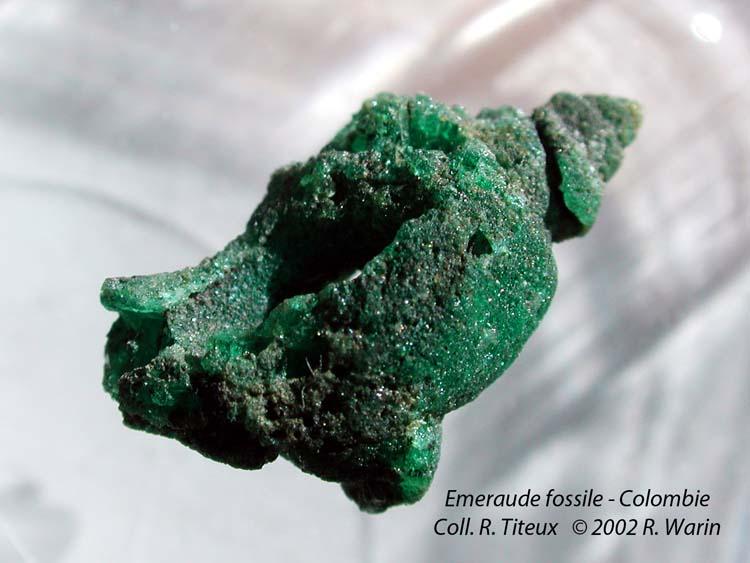| View previous topic :: View next topic |
| Author |
Message |
Cesar M. Salvan
Site Admin
Joined: 09 Jun 2008
Posts: 127
Location: Alcalá de Henares



|
 Posted: May 14, 2013 03:58 Post subject: Re: When can a fossil be also considered a mineral? Posted: May 14, 2013 03:58 Post subject: Re: When can a fossil be also considered a mineral? |
|
|
| Quote: | | The basic definition of a mineral is that it is a naturally occurring inorganic chemical. |
And what about the organic chemicals that are defined as minerals, like the cited Fichtelite?
| Quote: | | Just would like to learn what wiser people in the forum are thinking about a fossil being also a mineral. Some ammonites are made of pyrite, you very probably know. Are they a fossil, a mineral, or both? |
Fossil and minerals are not excluding categories. A fossil composed by one mineral, is a mineral. And a fossil. You can not claim "pyrite pseudomorph after ammonite" because "mineral" regards to its chemical nature and "fossil" regards to its origin. As 'gemlover' said, the fossil is a cast and, hence, the same biological origin could lead to different mineral assemblage after fossilization.
I insist, the only cases I know of minerals that are also fossils themselves (i.e. in which "mineral" and "fossil" are not separate categories or definitions) are organic minerals like Fichtelite.
|
|
| Back to top |
|
 |
Philip G

Joined: 13 Aug 2009
Posts: 54
Location: North Lancashire, England



|
 Posted: May 14, 2013 05:12 Post subject: Re: When can a fossil be also considered a mineral? Posted: May 14, 2013 05:12 Post subject: Re: When can a fossil be also considered a mineral? |
|
|
Hi all,
I have always found this specimen quite interesting.
The pictures show what i believe to be hematite encasing a solitary rugose coral but leaving the fossil itself totally unhematised. The small cavity in the coral contains micro crystals of dolomite.
From the Carboniferous limestones, Florence Mine, Egremont, West Cumbria, England.
Philip
| Description: |
Hematite
Florence Mine, Egremont, Cumbria, England
12 cm x 9 cm |
|
| Viewed: |
72216 Time(s) |

|
|
|
| Back to top |
|
 |
alfredo
Site Admin

Joined: 30 Jan 2008
Posts: 1014



|
 Posted: May 14, 2013 07:01 Post subject: Re: When can a fossil be also considered a mineral? Posted: May 14, 2013 07:01 Post subject: Re: When can a fossil be also considered a mineral? |
|
|
Fossils could be divided into two types:
1) The dead organism's original organic material is preserved without replacement, as for example with Siberian mammoths frozen for 20,000 years, or giant ground sloths merely desiccated in dry caves, or human beings pickled in the acid waters of peat bogs. These fossils are NOT minerals, obviously.
2) The much more common type of fossil in which the original organic matter is replaced by mineral matter. These are obviously both fossils and minerals, and any distinction is merely semantic and due to the collection preferences of the person who has it. I'm sure most MINERAL collectors would not consider a fossil to be a mineral SPECIMEN unless it contained either visible crystals or some interesting replacement species (opal, vivianite, etc). A fossil composed of clay minerals is of course also a mineral, but few mineral collectors would consider it to be a mineral "specimen".
The definitions of "mineral" and "fossil" are pretty well established and it would be redundant to rehash them here, so what this discussion is really about is the definition of "specimen"!
|
|
| Back to top |
|
 |
Cesar M. Salvan
Site Admin
Joined: 09 Jun 2008
Posts: 127
Location: Alcalá de Henares



|
 Posted: May 14, 2013 07:14 Post subject: Re: When can a fossil be also considered a mineral? Posted: May 14, 2013 07:14 Post subject: Re: When can a fossil be also considered a mineral? |
|
|
| Alfredo, you forgotten the common case of fossils in which organic material hasn't been replaced by inorganic materials, but without preservation of original organic components. Is the case, for example, of amber (not mineral) or, again, fichtelite (a mineral).
|
|
| Back to top |
|
 |
Elise

Joined: 22 Dec 2009
Posts: 243
Location: New York State



|
 Posted: May 14, 2013 07:38 Post subject: Re: When can a fossil be also considered a mineral? Posted: May 14, 2013 07:38 Post subject: Re: When can a fossil be also considered a mineral? |
|
|
Hi Pete!
Maybe that was Bob Hazen's work? See our thread here: https://www.mineral-forum.com/message-board/viewtopic.php?p=13282#13282
Cheers
Elise
| Pete Richards wrote: |
The ultimate perspective is recent work (sorry, I should be able to quote a source, but I can't) which points out that early biological evolution produced photosynthesizing primitive plants that led eventually to an oxygen-rich environment, which is a major factor in forming most of the known minerals - many oxides and hydroxides, sulfates, carbonates, phosphates, etc..
|
_________________
Elise Skalwold |
|
| Back to top |
|
 |
Ru Smith
Joined: 13 Oct 2012
Posts: 362



|
 Posted: May 14, 2013 19:57 Post subject: Re: When can a fossil be also considered a mineral? Posted: May 14, 2013 19:57 Post subject: Re: When can a fossil be also considered a mineral? |
|
|
That is a fascinating coral enclosed in hematite, Philip. Brian Young has a paper in the Journal of the Russell Society (2012) which shows a colonial coral (?Siphonodendron sp.) preserved in hematite from the old Florence Mine dump. "The skeletal elements of the original coral are preserved in quartz surrounded by massive hematite."
My favourite example of mineralization of fossils is the replication of soft parts by very early precipitation of pyrite, such as is seen in the Ordovician of New York or the Devonian of Bundenbach in Germany.
| Description: |
Mimetaster hexagonalis, Lower Devonian, preserved in early-precipitated pyrite.
Bundenbach, Germany.
35 mm in ventral view on slab with ophiuroid. Published in Hohenstein (2004), BJR 77, 420-425, Fig. 4. |
|
| Viewed: |
39907 Time(s) |

|
|
|
| Back to top |
|
 |
Riccardo Modanesi
Joined: 07 Nov 2011
Posts: 631
Location: Milano


|
 Posted: May 15, 2013 07:36 Post subject: Re: When can a fossil be also considered a mineral? Posted: May 15, 2013 07:36 Post subject: Re: When can a fossil be also considered a mineral? |
|
|
| alfredo wrote: | Fossils could be divided into two types:
1) The dead organism's original organic material is preserved without replacement, as for example with Siberian mammoths frozen for 20,000 years, or giant ground sloths merely desiccated in dry caves, or human beings pickled in the acid waters of peat bogs. These fossils are NOT minerals, obviously.
2) The much more common type of fossil in which the original organic matter is replaced by mineral matter. These are obviously both fossils and minerals, and any distinction is merely semantic and due to the collection preferences of the person who has it. I'm sure most MINERAL collectors would not consider a fossil to be a mineral SPECIMEN unless it contained either visible crystals or some interesting replacement species (opal, vivianite, etc). A fossil composed of clay minerals is of course also a mineral, but few mineral collectors would consider it to be a mineral "specimen".
|
Hi to everybody!
According to the definitions of Hugo Strunz, even a shell or a bone (including human bones) are to be considered minerals. From my personal point of view (it's just an opinion, don't misunderstand me!), I don't agree. A fossil IS a plant or animal rest or trace which WAS transformed into mineral or minerals by the time. This definition doesn't exclude the single pyrite crystal forming an ammonite IS a pyrite crystal, or the single quartz crystal forming a fossil shell IS a quartz crystal. Living shells and bones are NOT separate mineral species, but they are a mixture of EXISTING and CLASSIFIED mineral species (aragonite for shells and apatite for bones), and organic substances. The latter ones allow shells and bones to be "alive" structures of an organism. I hope I was clear enough.
Greetings from Italy by Riccardo.
The definitions of "mineral" and "fossil" are pretty well established and it would be redundant to rehash them here, so what this discussion is really about is the definition of "specimen"!
_________________
Hi! I'm a collector of minerals since 1973 and a gemmologist. On Summer I always visit mines and quarries all over Europe looking for minerals! Ok, there is time to tell you much much more! Greetings from Italy by Riccardo. |
|
| Back to top |
|
 |
Don Lum

Joined: 03 Sep 2012
Posts: 2923
Location: Arkansas



|
 Posted: May 16, 2013 17:34 Post subject: Re: When can a fossil be also considered a mineral? Posted: May 16, 2013 17:34 Post subject: Re: When can a fossil be also considered a mineral? |
|
|
| Carles Millan wrote: | | Don Lum wrote: | | I don't know if there are any wiser people on the Forum than you, Carles. |
By the hundreds ! |
Carles, I think that the software we all enjoy on The FMF (Freeware: Mineral Database ) looks like the work of a genius.
Sincerely,
Don
_________________
hogwild |
|
| Back to top |
|
 |
Don Lum

Joined: 03 Sep 2012
Posts: 2923
Location: Arkansas



|
 Posted: May 16, 2013 18:46 Post subject: Re: When can a fossil be also considered a mineral? Posted: May 16, 2013 18:46 Post subject: Re: When can a fossil be also considered a mineral? |
|
|
| Carles Millan wrote: |
From that post an interesting question arises. When can a fossil be also considered a mineral? |
Hi Carles,
I found some information that you might find interesting.
Excerpt from raysrockandminerals:
FLORIDA AGATIZED CORAL
In 1979 the State of Florida designated Agatized Coral as its state stone (although it’s actually a fossil…). Coral falls into the marine animal class of Anthazoa. These living polyps secrete calcium carbonate to form tropical ocean reef systems. Agatized coral occurs in one of three ways: Silica will replace a portion of the coral, creating geodes, sometimes with brilliant quartz crystal clusters inside. These crystals are very small. They are commonly referred to as druzy quartz. Sometimes they are replaced with botryoidal (grape like) quartz formations. In extremely rare instances water will become trapped inside the geode. These are called enhydros. In the second occurrence, the Coral is completely replaced by silica creating some exotic specimens. A third way is when the coral is trapped in lime stone and is slowly dissolved, leaving a perfect cast. Then silica seeps into the cavity duplicating the coral in silica. This is called a pseudomorph (one mineral replacing another). Although it doesn’t sound like a drawn out process, it is. It takes about 20-30 million years for this to happen.
In Florida, agatized coral is found in three main locations: (1) Tampa Bay around Ballast Point (2) the Ecofina River in the panhandle approximately 15 miles west of Perry, Florida off US 98, and (3) the Withlacoochee/Suwannee river beds.
Georgia shares the Withlacoochee River with Florida. Near Clyatteville, Georgia this river flows over an ancient coral reef from the Oligocene Epoch which began about 38 million years ago and lasted for approximately 11 million years. These ancient coral reefs become exposed in river beds which, over time, erode and cut valleys through sediment exposing the coral.
Agatized coral is found in a variety of colors. The color depends largely upon the minerals present in the silica when the process was taking place. The colors are typically gray, brown, honey and white, but they are also found in red, black, orange and sometimes blue. Geodes found in these areas of Florida and Georgia can be melon size or even pumpkin size if you are lucky.
The beautiful specimens of agatized coral that occur at Ballast Point area in Tampa Bay have been known since the late 19th century. These specimens are actually chalcedony pseudomorphs after coral or aragonite (the mineral which made up the original coral skeletons). The exterior details of the specimens from this and other locations are often preserved in exquisite detail, thanks to the silicification process. However, interior details of the original coral skeleton are often obscured in geodes, replaced by chalcedony.
Agatized and silicified corals are largely associated with Tertiary marine sedimentary formations from the eastern Florida panhandle and nearby south Georgia through central and west Florida, as far south as Sarasota County. Calcified corals have been found in several southern Florida localities. Most of the major deposits seem to occur in upper Oligocene and lower Miocene shallow marine limestone and marls.
So if the State of Florida recognizes fossilized agate as The State Stone, then maybe it is a stone :-).
_________________
hogwild |
|
| Back to top |
|
 |
Carles Millan
Site Admin

Joined: 05 May 2007
Posts: 1538
Location: Catalonia



|
 Posted: May 17, 2013 04:53 Post subject: Re: When can a fossil be also considered a mineral? Posted: May 17, 2013 04:53 Post subject: Re: When can a fossil be also considered a mineral? |
|
|
| Don Lum wrote: | | Carles Millan wrote: | | Don Lum wrote: | | I don't know if there are any wiser people on the Forum than you, Carles. |
By the hundreds ! |
Carles, I think that the software we all enjoy on The FMF (Freeware: Mineral Database ) looks like the work of a genius. |
I'm very glad that the software can be useful for somebody.
|
|
| Back to top |
|
 |
Carles Millan
Site Admin

Joined: 05 May 2007
Posts: 1538
Location: Catalonia



|
 Posted: May 17, 2013 05:02 Post subject: Re: When can a fossil be also considered a mineral? Posted: May 17, 2013 05:02 Post subject: Re: When can a fossil be also considered a mineral? |
|
|
| Don Lum wrote: | | So if the State of Florida recognizes fossilized agate as The State Stone, then maybe it is a stone :-). |
The US Supreme Court unanimously decided long ago (year 1893) that tomatoes were NOT a fruit but a vegetable.
|
|
| Back to top |
|
 |
Pierre Joubert
Joined: 09 Mar 2012
Posts: 1605
Location: Western Cape



|
 Posted: May 17, 2013 09:40 Post subject: Re: When can a fossil be also considered a mineral? Posted: May 17, 2013 09:40 Post subject: Re: When can a fossil be also considered a mineral? |
|
|
| Carles Millan wrote: | | Don Lum wrote: | | So if the State of Florida recognizes fossilized agate as The State Stone, then maybe it is a stone :-). |
The US Supreme Court unanimously decided long ago (year 1893) that tomatoes were NOT a fruit but a vegetable. |
So, what does the 'supreme court' of Carlos say, is it a stone or not? :-)
_________________
Pierre Joubert
'The tree of silence bears the fruit of peace. ' |
|
| Back to top |
|
 |
Roger Warin

Joined: 23 Jan 2013
Posts: 1246



|
 Posted: May 17, 2013 10:56 Post subject: Re: When can a fossil be also considered a mineral? Posted: May 17, 2013 10:56 Post subject: Re: When can a fossil be also considered a mineral? |
|
|
Hello,
Without giving a lesson, I think fossilization is actually a pseudomorphosis whose shell (for example) gives the form.
A conventional mineral pseudomorphosis is the gradual transformation of azurite into malachite. The material turns without transport. The resulting crystal of malachite retains the shape of the initial azurite. But malachite is not a single crystal.
A fossil is a residue of an organic, a plant or animal skeleton. Silica impregnated wood fibers whose soft material disappears.
A shell will fill with sediment, calcite, pyrite, etc…
In general, a fossil will be a differentiated rock or a mineral depending on the composition.
I'll post another interesting topic, I think.
Roger.
|
|
| Back to top |
|
 |
Roger Warin

Joined: 23 Jan 2013
Posts: 1246



|
 Posted: May 17, 2013 11:21 Post subject: Re: When can a fossil be also considered a mineral? Posted: May 17, 2013 11:21 Post subject: Re: When can a fossil be also considered a mineral? |
|
|
Hi,
At the 2002 Munich Show, my friend Roger Titeux asked me to buy two fossil specimens. I refused for lack of money. But I regret it now, and for a good reason.
Both fossils were made of emerald. I think the emerald has replaced the calcite filling the shell, in a flow of hydrothermal waters.
These fossils come from the famous Valley of Colombia, and I think remember from Gachala.
I think in this case, we can say that the fossil is a mineral.
Here are the photos.
Roger.
| Description: |
Emerald - fossil
Colombia, Gabachla ?
3-4 cm |
|
| Viewed: |
39821 Time(s) |

|
| Description: |
Fossil - emerald
Colombia, Gabachla ?
3-4 cm |
|
| Viewed: |
39183 Time(s) |

|
|
|
| Back to top |
|
 |
Don Lum

Joined: 03 Sep 2012
Posts: 2923
Location: Arkansas



|
 Posted: May 17, 2013 11:41 Post subject: Re: When can a fossil be also considered a mineral? Posted: May 17, 2013 11:41 Post subject: Re: When can a fossil be also considered a mineral? |
|
|
Roger,
That is an amazing specimen and great photos. Thank you.
Don
_________________
hogwild |
|
| Back to top |
|
 |
|





